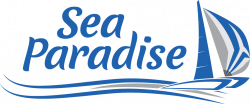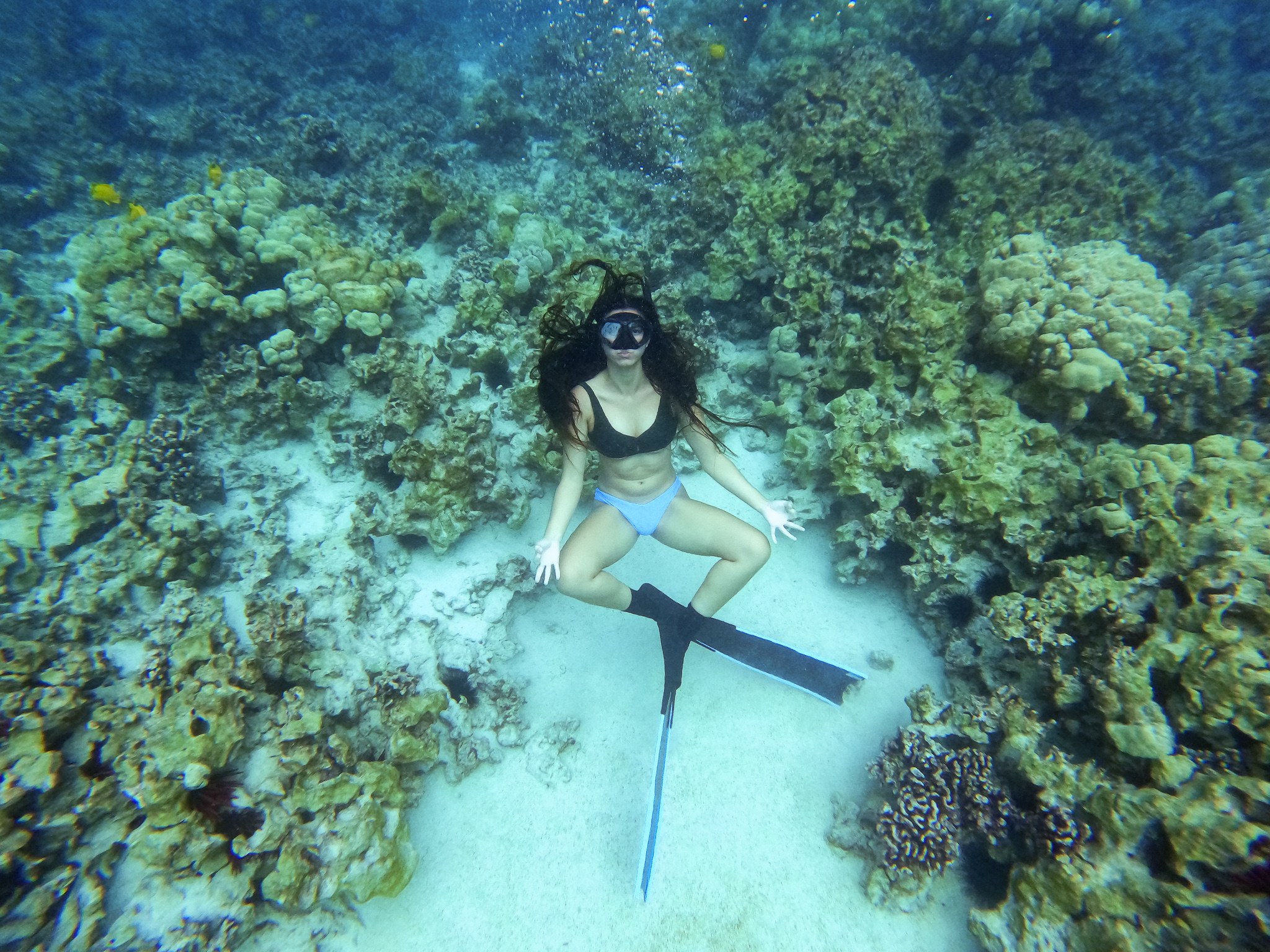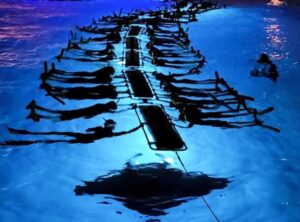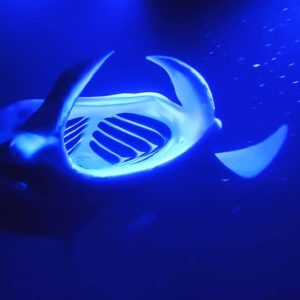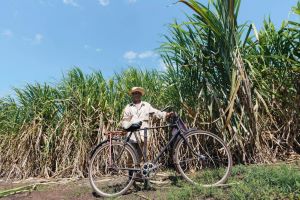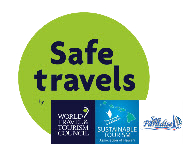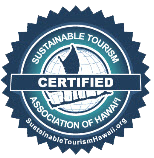More middle: more traditional Hawaii travel tips that you’re probably expecting like how much stuff costs, what the weather is like, when whale season is, how to dress, etc.
The end: a roundup of topics that I feel somewhat strongly about including illegal vacation rentals (yikes, you don’t want to get caught in one of these), post COVID travel tips, and what’s considered a “must do” in Hawaii.Don’t miss these Hawaii “Must Dos”
Right…like I said…a bit of a mish mash but hang in there and I promise you’re going to come out of this post with a LOT of insight that’s going to make your trip to Hawaii go MUCH more smoothly.Hawaii Overview
Hawaii is a chain of islands in the Pacific Ocean that is about 2000 miles from the US mainland. There are four main islands (Oahu, Maui, Kauai, and the Big Island-also known as Hawaii), two smaller islands near Maui (Molokai and Lanai) and two other islands that aren’t visitable (Kaho’olawe and Ni’ihau). Oahu is considered the main island (home to Honolulu-the state’s capital, Waikiki, and over a million people) but it’s not the “Big Island.” The four main islands are all easily accessible from the US mainland. Molokai and Lanai are easily reached from Oahu or Maui. Here’s a list of each island’s major city and airport code: Oahu/Honolulu (HNL) Maui/Kahului (OGG) Kauai/Lihue (LIH) Big Island/Kona (KOA) BIg Island/Hilo (ITO)Molokai (MKK)
Lanai (LNY) It seems like a world away but Hawaii is actually only a 5 or 6-hour flight from California. It’s 6 hours going to Hawaii, and 5 hours coming back from Hawaii. There are so many more direct flights to Hawaii now from the midwest and even the east coast. From the midwest (Dallas, Chicago, Denver, Austin, etc.) you’re looking at 8-9 hours and from the east coast (New York, Boston, Orlando, etc) it’s usually 11-12. The Hawaiian Islands run on the Hawaii-Aleutian Time Zone. Hawaii also doesn’t observe Daylight Savings Time so they’re 3 hours behind West Coast time (6 hours behind East coast time) when we’re on Daylight savings time, and 2/5 hours when we’re not. The Hawaiian Islands were formed by volcanic eruptions and the age of each island inversely corresponds to its size (and some of its features). Kauai is the oldest island (formed almost 6 million years ago) and also the smallest island. Oahu is the second oldest island and second smallest. Maui is the second youngest island (formed about 1.3 million years ago) and second largest island. And the Big Island comes in as the baby island and the only island with ACTIVE volcanoes which means that it’s still growing!! Maui and the Big Island are the only islands where you’ll find the dramatic black sand beaches (formed when lava meets the ocean) because they’re still relatively young. Oahu and Kauai are the islands with the most dramatic green jagged mountains because they’re older and have suffered more erosion. So in terms of size: Big Island > Maui > Oahu > KauaiAnd in terms of age: Kauai > Oahu > Maui > Big Island
Molokai and Lanai were originally part of Maui but as the islands have sunk, they’ve become three separate islands.
As far as which island is best or which you should visit, there’s not really a definitive answer. Although people who have visited before usually have very strong opinions ; ) each island is fairly unique and has a lot to offer. While each island has a handful of attractions (natural and manmade) that you’ll only find on that island, EVERY island has supherb beaches, snorkeling, water sports, resorts, etc. In other words, your “dream Hawaiian vacation” can be had on each island. Read more about figuring out which island to visit here and a comparison between Maui and Kauai here.What You Need to Know Before You Go to Hawaii
It may feel like a different country, but remember, you’re still in the US. Hawaii has a very distinct culture and its location in the middle of the Pacific Ocean often makes it feel like a foreign land, so many visitors question how things are done. Here’s the deal: everything works like it does back home, except when it doesn’t : ) Seriously though, your phone service works like normal, you don’t need a passport (you’d be surprised how often people ask this), and you don’t call the US mainland “the states” like you would when in Europe. But you will find yourself subject to the quirks of “island life.” Things move slower so relax and just go with the flow. This leads into the first big thing you need to know:Yes, Hawaii is the 50th state in the Union, but there are many people who consider it an illegally occupied sovereign nation. Whether or not you agree with that is beside the point, but understanding the perspective and respecting the people of Hawaii will go a long way towards enriching your travel experience.
Here’s a quick rundown: The Kingdom of Hawaii was a thriving monarchy under the rule of King Kamehameha I (united the islands in 1810). The first missionaries showed up in 1820. The first sugar cane plantation was opened in 1835, and the Hawaiian Islands developed a reputation as prime agricultural land (this is when American influence in Hawaiian government begins). By the 1850s, the plantations were booming and they needed more labor. Immigrants were recruited from China, Japan, Korea, the Philippines, and Portugal. In 1882, the Iolani Palace was completed and it had electricity before the White House and Buckingham Palace. In 1887, the US began leasing Pearl Harbor. Later in 1887, a group of largely non-Hawaiians drafted a new constitution (signed under threat of force) that stripped the King of power (later called the Bayonet Constitution). In 1891, Lili’uokalani (the last Queen of Hawaii) ascended to the throne and in 1893 she attempted to pass a new constitution that would give power back to the people of Hawaii. It gets really complicated from here, but basically a coup to overthrow the Kingdom of Hawaii followed immediately, designed largely by American businessmen and backed by the US military (a show of force mostly). To protect American property and interests in the Kingdom of Hawaii, the Republic of Hawaii was formed as the US tried to move towards annexation.Interestingly, the treaty to annex Hawaii never passed the Senate and it gets a little murky as to how President McKinley eventually signed the Newlands Resolution in 1898 which created the Territory of Hawaii. Sanford B. Dole (yep, the fruit guy : ) was appointed as the first Territorial Governor which tells a lot of the story, and Queen Lili’uokalani eventually died under house arrest.
Common Courtesy Rules for Visitors to Hawaii
Don’t act like an entitled tourist. It’s the worst. Just because you’re spending a lot of money to be there doesn’t mean you can 1) act like a jerk, 2) be demanding, 3) do whatever you want. Hopefully this sounds super dramatic to you and something that should go without saying WHEREVER YOU ARE IN THE WORLD, but hey, some people are crazy and it has to be said. Need an example? Have you seen the rainbow eucalyptus trees? They’re crazy cool. A eucalyptus tree found in Hawaii whose bark is literally like a rainbow. You know what people do? THEY CARVE THEIR NAMES INTO IT. Why on earth would you do that??? Just stop.
Don’t trespass on private property. Again, seems like a no brainer right? You’d be surprised. Just because you read about a hike to a waterfall in a guidebook doesn’t mean you can go there if it’s on private property. This is particularly a big problem along the Road to Hana on Maui. If you have to climb around a gate or ignore posted signs, don’t do it. Also, it’s generally appreciated if you don’t geotag locations on social media of sites that are considered secluded or special to locals (even if it’s legal to access). Don’t touch the sea turtles or the monk seals. Both Hawaiian Green Sea Turtles and Hawaiian Monk Seals are protected species meaning IT’S A FEDERAL OFFENSE TO TOUCH THEM. You’re required to keep a MINIMUM 10 foot perimeter from these creatures whether they’re in the water or on the land (it’s not uncommon to see them sunning themselves on beaches). And if you’re in the water you should stay even further away because you have less control. Some beaches (especially Ho’okipa on Maui) set up fairly large perimeters around turtles and monk seals (more common for the monk seals because they’re more rare) so be sure to respect the perimeter and don’t be one of those people that ducks under a rope because you’re “technically allowed to be 10 feet away.” The good news is that the numbers for these species (especially the Hawaiian Green Sea Turtles) is GROWING because of their protected status. Tread lightly on the environment. The staggering number of visitors that Hawaii receives annually means it can be a real strain on the islands. But there’s a lot you can do to make a difference. Pick up your trash. Heck, pick up other people’s trash. Use Reef Safe Sunscreen. Tons (literal TONS) of sunscreen ends up washed around Hawaii’s beautiful coral reefs each year and it’s increasingly being understood how harmful it is (how much conditions improved during the COVID shutdowns was pretty astounding). Hawaii recently passed a bill making it illegal to sell sunscreen with two ingredients found to be most harmful to reefs and it makes a HUGE difference when people wear reef safe (or at least reef friendly) sunscreen when in the ocean. Read this post for more information about reef safe sunscreen. Don’t drive like a jerk. Or just be clueless in general. Remember, while you’re on vacation, the locals are not. Be aware of your surroundings and try not to hold anybody up. When in doubt, just pull over and let them go around. Don’t stop your car in the middle of traffic because you want to take a picture of a rainbow or a mongoose or a chicken or a waterfall (every other visitor there also wants to do the same and it can create a real traffic jam which isn’t something you want to deal with every day when you’re trying to get to work). Don’t park illegally by the side of the road (super important along the road to Hana on Maui). Don’t park in front of business and then leave your car there while you’re at the beach. Know the one lane bridge rule: there are places (mostly along the road to Hana on Maui or the north shore of Kauai) where there are one-lane bridges. The local custom is to let 5-7 cars go at a time. If your side is going, count how many cars go ahead of you to determine whether you should go with this batch or stop and let the other side go first. These are all local courtesies. Locals aren’t grumpy that tourists are there, but they do get frustrated when they’re trying to go about their daily business and they can’t. Imagine dropping your kids off for school, going to the grocery store, doing WHATEVER and having to battle hundreds of people and cars who are kind of lollygagging around. Here’s the deal: you probably will get in somebody’s way at some point, but your attitude goes a long way. Be aware, apologize, smile, let them go ahead. Just be nice. Practice ocean safety. And safety in general. The ocean is no joke. Quite a few people drown every year and a lot of it is avoidable. Never get in the water without watching it for a while. Never turn your back to the ocean. Do you really need to be snorkeling on your own 100 yards from shore? Stay away from blowholes. Stay away from rocky areas when there’s high surf (there’s always tempting natural pools to swim in but it’s so risky). Don’t swim at beaches where there are warnings posted. Stay on trails. It’s not like locals don’t want you to have any fun. But besides these things being in the best interest of YOU, here’s something to think about: for every first responder/coast guard/helicopter that’s dispatched to help someone who got themselves into a not so smart situation, those are resources that aren’t available to local families when they need help. And on an island with finite resources, that can be a big deal. Know the lingo or at least make an attempt. Nobody is going to be mad at you for not speaking Hawaiian (not many people do anymore), but it goes a long way to make an effort. “Aloha” means hello, goodbye, and love. “Mahalo” means thank you. “Keiki” means kid (you’ll see this a lot…kids menus, etc.). Pronouncing Hawaiian words can be TRICKY. Here are a couple of tips: The vowels are pronounced like Spanish: “A” = ah “E” = eh “I” = ee“O” = oh
“U” = oo 99% of the time you pronounce every letter distinctly The exceptions are: “ao” is pronounced “ow”, “ai” is pronounced “eye”, “au” is pronounced “ow” Something else useful to know: “Hawaiian” refers to anyone born with Hawaiian blood. Like, ancient Hawaiian blood, not just born in the state. “Local” refers to anyone born in Hawaii (except usually white people but sooooometimes them too). “Haole” refers to white people and tourists in general. It can be derogatory, but not necessarily. The term “kama’aina” is also thrown around which refers to anyone from or living in Hawaii regardless of their ethnicity.Miscellaneous Hawaii Travel Tips
Here’s a smattering of tips, FAQs I get a lot, plus just a few topics it’s good to be aware of when planning your Hawaii trip:How much does Hawaii cost? In short…as much as you want it to cost. While I would never call Hawaii a “cheap” travel destination, it can certainly be done on a budget. I’m all for saving money, but I wouldn’t call myself a budget traveler (I like to research how much something is going to cost according to how I like to travel and then save until I can afford it). In general, you can find random airfare deals, stay in cheap condos, cook all of your meals, and just bum around the beach for free and that’s easy enough to figure out. Or you can spend $20K+ on a lavish once in a lifetime super vacation. Most people are somewhere in the middle. In general, most things do cost more in Hawaii than on the mainland. I mean, you’re on an island in the middle of nowhere and everything has to be shipped in. But if you’re coming from high cost of living areas on either coast, or if you’re used to vacation in high tourist areas, you’re probably not going to be too terribly phased by the prices. If you live in the midwest and mostly go to Branson, you’re likely to be shocked. Here are a couple of posts to give you a better idea:
I always book through Discount Hawaii Car Rentals because they have the best prices. They’re seriously the only company I ever use. They’ll give you the very best prices, you don’t have to reserve with a credit card or pay until you show up, you can cancel and re-book anytime if you find a better rate, and they usually have a special that adds additional drivers for no fee. It’s a no brainer. Click here to check rates for your trip.
Take your own bags. Hawaii banned plastic shopping bags a long time ago so either bring your own reusable tote bags or pay $0.50 at places like Target and Walmart (most grocery stores have paper bags available. There’s a movement to get single use plastic items like silverware and straws banned as well but TBD on that.
More Hawaii Travel Tips I Feel Strongly About
Don’t book illegal vacation rentals. This has started to become a major problem in the last few years, but it’s starting to reach a boiling point. The rise in popularity of sites like Airbnb has resulted in a lot of property being bought by wealthy folks from the mainland (or internationally) and being rented out as short term vacation rentals to visitors. In addition to creating a housing crisis (it becomes much harder for local families to afford to be able to stay in the area), it also changes the community (i.e. more businesses and amenities catered towards tourists and less towards residents).
What does that mean for you? To get this problem under control, different counties (islands) have been passing (or starting to enforce) legislation that cracks down on illegal rentals. Lately, it’s been most dramatic on Oahu where there have been estimated to be as many as 10,000 illegal vacation rentals, but the other islands are turning their attention to cracking down on this problem. A lot of visitors are shocked that it’s even an option to book something illegal on Airbnb or Vrbo, but the truth is those sites are just marketplaces and it’s up to YOU to use due diligence to make sure what you’re booking is on the up and up. I’m not talking about shady listings where they’re trying to scam you. 99% of these properties are legitimate homes, apartments, ohanas (a separate dwelling on somebody’s property) either rented out by the owners or a property manager. Just like Airbnb works anywhere in the world. They range in price, size, location, and amenities. But they don’t have permits to be operating as short term vacation rentals and they’re located in areas of the island that are considered residential (we’re not talking condos).In short…it’s always been illegal to rent a house on a site like Airbnb or Vrbo that didn’t have a permit (the majority of them), but now they’re enforcing it.
As the renter, (right now) you won’t get fined if the owner gets caught, but you could be left with no place to stay on short notice. So basically…if you’re set on alternative forms of accommodation besides a resort, hotel, or condo, you’ll need to read up on the zoning for each island and either pick something that’s in a zone that doesn’t require a permit, or pick something that does have a permit. I’ll be honest…there aren’t a ton of permitted short term vacation rentals on each island (outside of tourist areas where they’re mostly condos) so the ones you will find tend to be not super cheap. I will give you a heads up about a situation on Oahu…their official law is that short term rentals are any rental less than 30 days so as a work around a lot of places will say they have a 30 day minimum on Airbnb but kind of squirrel around and only charge you for the week you want to stay. It’s still illegal and it’s uncertain how it’s going to be handled. I don’t want to scare you away from using sites like Vrbo and Airbnb, because they actually have amazing places to stay but I SERIOUSLY SERIOUSLY SERIOUSLY recommend only using them to book places in tourist zones. On Oahu, book places in Waikiki, Ko’olina, and Turtle Bay. On Maui, book places in Ka’anapali up to Kapalua and in Kihei and Wailea. On Kauai, book in Poipu and Princeville. On the Big Island, book around Kona and up around Waikoloa on the Kohala Coast. Those obviously aren’t the only places you can find legal rentals on each island, but those tend to be the major hubs. I’m not trying to discourage people from staying in more residential parts of the island (if done legally), BUT just be extra careful to be aware of your surroundings and know that not everyone around you is on vacation. Imagine stopping by the local market/deli to grab breakfast on your way to drop the kids off at school and not being able to park because all of the tourists have used the few spots as beach parking. It’s stuff like that that sets the local community a bit on edge sometimes. It should go without saying, but when you’re staying in a neighborhood you’re not staying in a resort and not everyone is there to cater to you on your vacation. But that’s what makes it a more local experience! I think the best place to book vacation rentals in Hawaii is on Vrbo. You can filter by price, bedrooms, etc. to find exactly what you’re looking for. Don’t book flights before you find a place to stay. My inbox is full of messages right now from people who booked cheap flights to Hawaii and are having a hard time finding a place to stay. It’s not that there’s NO place to stay, but things are either waaaaay more than they thought for something basic or they were hoping to stay at a nice place and everything is sold out. If where you stay is important to you (it’s way more important to me than saving on a flight), make sure the dates work with accommodations before you book. You can usually save a whole lot more by picking your dates around availability/offers at resorts and hotels than you can booking cheap flights. In my experience, most of the time airfare doesn’t fluctuate as much as rooms do. Traveling to Hawaii post COVID is a TRIP. Hopefully this becomes irrelevant sooner rather than later, but travel to Hawaii is pretty crazy right now. Travel everywhere is pretty crazy right now. The post COVID travel landscape seems to look like paying way more for way less, but that’s just the way it is. Demand is greater than supply and right now that means a huge shortage of rental cars and activities/tours booking MONTHS in advance (mostly because they’re still at limited capacity). Restaurants are even booked up months in advance. Service at most places is a little substandard because there aren’t enough workers and there’s too many customers. The workers who are there are often getting nasty treatment from angry customers. That’s misplaced for sure. This situation isn’t unique to Hawaii, but since they’re very remote islands and resources are finite, it seems like an extra big problem. If you’re choosing to travel right now (that’s right…travel is a privilege), pack your patience and be kind. If you have super over the moon expectations or this is a once in a lifetime trip for you, maybe consider delaying for a bit until things can get sorted out. “Is (fill in the blank) worth it?” Wow I get this question a lot. I used to try to answer it based on my personal experience and opinions and a delicate cost/benefit analysis plus trying to figure out what the question asker’s expectations are. Here’s what I’ve come to realize….if you’re asking if something is worth it…it’s probably not…FOR YOU. Different people have different expectations and also tolerances for spending money. Some people don’t think anything of dropping $300 on dinner for 2 and some people could never stomach that in a million years NO MATTER WHAT. Value for money and time is very subjective and everybody likes to/is comfortable spending their time and money in different ways. Same thing when people ask if something is a “must do.” “Is Pearl Harbor really a must do?” If you’re asking, it’s probably not. For me, it absolutely is. On my first trip to Oahu, I was only there for two days and I spent one of them at Pearl Harbor. But I have friends who have been to Oahu many times, have never been, and absolutely don’t feel like they’re missing anything. So if you read a normal amount of information/reviews about something and you’re still wanting to ask if (fill in the blank) is worth it…it’s probably not.You’re allowed to spend your Hawaiian trip however you want and in a way that you’ll feel good about. You don’t HAVE to go to a luau. You don’t HAVE to go out on a snorkel boat. You don’t HAVE to make reservations for that one restaurant everyone is talking about when the idea of spending that much money on dinner makes you feel kind of ill.
Take everything you read with a grain of salt. I once had a reader reach out to me and say that she had planned a grand trip to Europe the year before with no problem but planning her trip to Hawaii was turning into the biggest struggle because every review she read about everything said it was 5/5 stars earth shatteringly amazing. How do you pick a resort when everybody that stayed at each place says it’s the most magnificent resort in Hawaii hands down? How do you pick a luau when every review says it was the best luau they’ve ever been to (without saying how many luaus they’ve been to…)? It’s tough. It’s easy enough to get an accurate picture of most places based on reviews and group consensus, but the thing about Hawaii is that everyone is relaxed, happy, and on their dream vacation so they’re just super positive. There’s not a whole lot of negativity which is sometimes where the most insightful reviews come from. So….read through this blog. I’ve spent a LOT of time in Hawaii and also researching EVERYTHING in and about Hawaii so I have a much broader perspective than most people who can only speak to what they did on their 7 day vacation. Also…if you’re reading reviews (TripAdvisor is my favorite) I always filter to read the negative reviews first and pay attention to anything specific they say (general disgruntledness is as unhelpful as a glowing vague review). Do they mention anything that’s a particular trigger for you? Are the things that bothered them not of a particular concern to you? Same thing with the positive reviews…are they super specific or pretty generic? One detailed review is more helpful than 100 “it was amazing!!!” reviews. So to wrap that up, be clear about what you enjoy, what you don’t enjoy and don’t feel like you have to do everything that’s recommended on the internet. You’re allowed to spend your vacation how you want to spend it. There’s nothing that’s such a “must do” or so “worth it” in Hawaii that you should do it even if you’re not particularly interested.